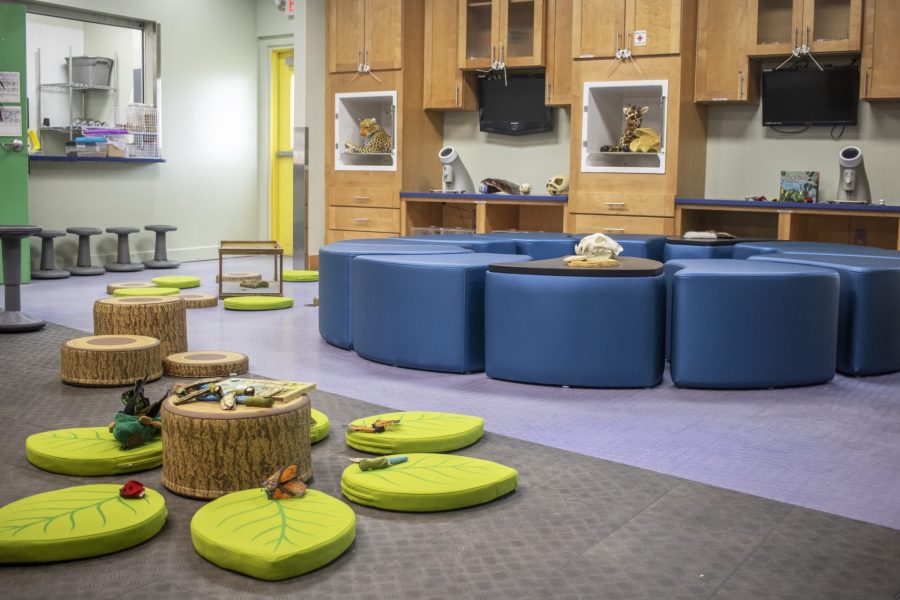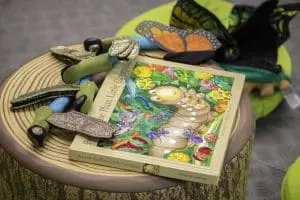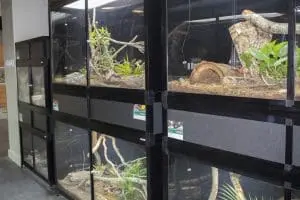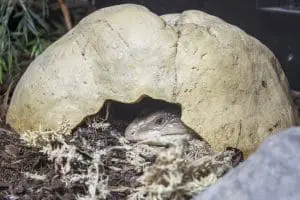

We hope our Wildlife Discovery Hub inspires future scientists and educators!
You may remember that we have an indoor space at the Zoo, formerly called the Wildlife Detective Training Academy, that has served many purposes over the years. It has called lots of species home, been used for countless education programs, had hundreds of children play in the sand pit, encouraged little ones to be veterinarians on stuffed animals, and much more. This space has recently undergone an incredible renovation – and a name change! Allow us to introduce the Wildlife Discovery Hub (WDH).
This amazing project was made possible by a gift from the family and friends of the late Charles Marzzacco, a scientist, teacher and life-long learner. The goal was to make a functional, appealing space for teachers to engage their students and get children of all ages interested in learning about science – everything Charles stood for.
The renovations were a huge collaboration between the Zoo’s Animal, Education and Maintenance Departments, each of which played a huge part in making the WDH what it is today.
A Unique Learning Environment
 Although the WDH will not be open to the public, it will be used for a variety of education programs such as summer camps, preschool, Zoo Teens, and maybe even field trips! In addition to improving the habitats of some of our animal ambassadors, we also wanted to create a modern learning space to better meet the needs of 21st century students. One of the key features in the room is the incorporation of flexible seating, which allows students to have control over their own learning environment by selecting where and with whom they work.
Although the WDH will not be open to the public, it will be used for a variety of education programs such as summer camps, preschool, Zoo Teens, and maybe even field trips! In addition to improving the habitats of some of our animal ambassadors, we also wanted to create a modern learning space to better meet the needs of 21st century students. One of the key features in the room is the incorporation of flexible seating, which allows students to have control over their own learning environment by selecting where and with whom they work.
“This approach facilitates collaborative learning and promotes the development of communication and higher order thinking skills,” said Amy Shea, one of the Zoo’s Education Curators. “Learners who use this room will also be able to livestream into our Sea Turtle Healing Center, giving them the opportunity to talk in real time to our team who cares for sick and injured local sea turtles.”
We hope the space will teach learners about some unique species and foster a love for the natural world!
Home Sweet Home
 When we got the opportunity to renovate this space, our animal care team was able to identify a few different areas in which we could improve the wellbeing of the residents that call the WDH home.
When we got the opportunity to renovate this space, our animal care team was able to identify a few different areas in which we could improve the wellbeing of the residents that call the WDH home.
So, what species call the WDH home?
We refer to this group of residents as “animal ambassadors” as they act as ambassadors for their species to help educate how important they are to the natural world. By housing these animals in a non-public area of the Zoo, we allow them to have natural rest days, give them choice and control over their participation in programs, and open up the space to encourage different training opportunities.
The Animal Ambassadors team cares for all of the WDH animals. “This team worked incredibly hard to increase the animal welfare for all species involved in this project,” said Mack. “They worked tirelessly to get the habitats, and all necessary components, together to make the habitats great!”
Renovating Our Animal Ambassador Habitats
 When the WDH received its facelift, we were able to take a closer look at upgrading the habitats that we provide for all 22 of its residents, especially our reptiles. We created more naturalistic habitats for our reptiles with live plants, better basking areas, accurate humidity changes and an increase in overall space for many of the residents. This allowed us to ensure that we could accurately mimic the natural ranges of each species. In addition, each habitat will automatically shut on and off their light fixtures to mimic natural day and night cycles.
When the WDH received its facelift, we were able to take a closer look at upgrading the habitats that we provide for all 22 of its residents, especially our reptiles. We created more naturalistic habitats for our reptiles with live plants, better basking areas, accurate humidity changes and an increase in overall space for many of the residents. This allowed us to ensure that we could accurately mimic the natural ranges of each species. In addition, each habitat will automatically shut on and off their light fixtures to mimic natural day and night cycles.
“We will continue to improve these habitats over time by increasing natural rock work, revamping plant species offered and changing all habitat parameters to maintain their natural ranges,” said Mack Ralbovsky, Animal Ambassadors Curator.
Want to meet one of our animal ambassadors? Here’s what you can do!
Brevard Zoo is an independent, not-for-profit organization that receives no recurring government funding for our operating costs. Your generous support enables us to continue to serve our community and continue our vital animal wellness, education and conservation programs.